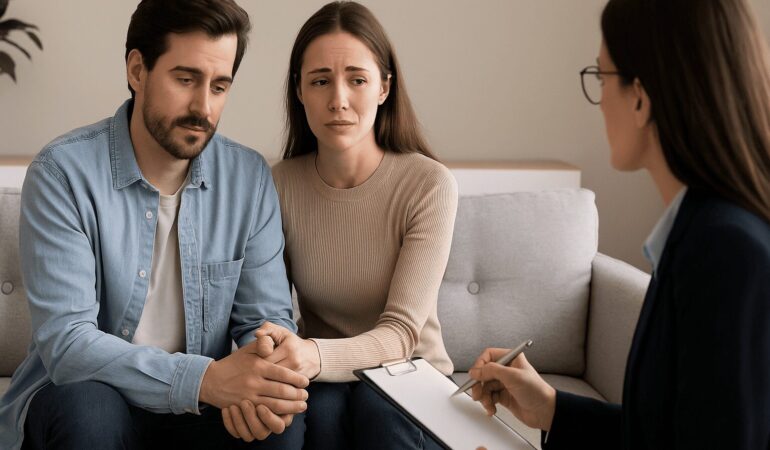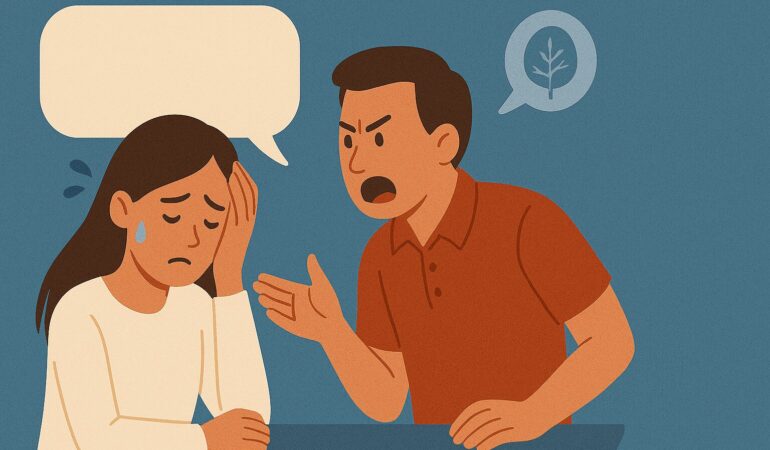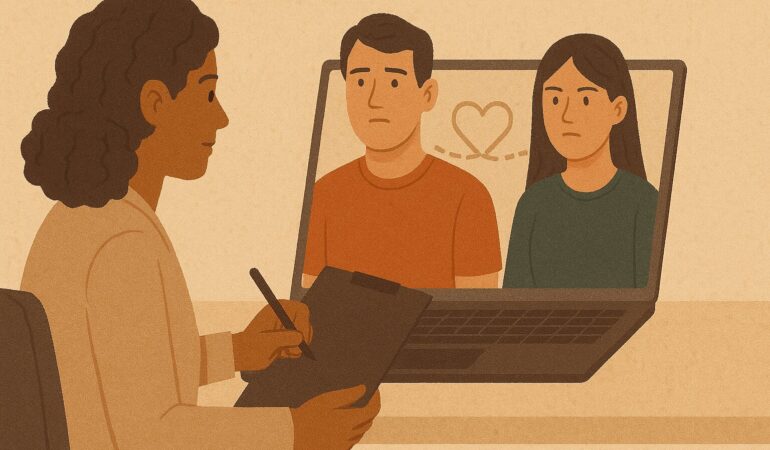Rebuilding Trust in a Relationship: A Therapist’s Guide to Healing Together
Trust is woven quietly into the everyday moments of a relationship. It’s the feeling that your partner is there for you, even when you’re apart. It’s the belief that the words they speak match the actions they take. And it’s the internal sense of safety that lets you relax, open up, and be fully yourself.
When trust breaks, that foundation can shake. You may find yourself replaying conversations, checking for clues, or feeling a pit in your stomach that never fully goes away. You may want to repair things, yet a part of you isn’t sure if you can.
If you’re here, it likely means something painful has happened. A betrayal, a lie, a pattern of withdrawal, or a moment that changed how you see your partner. And now you’re left wondering whether trust can ever be rebuilt.
At Here Counseling in Pasadena and Los Angeles, we walk with couples through these moments every week. Healing is possible. Slow, careful, grounded healing. Not a forced reset, but a rebuilding of something new—from honesty, safety, and connection.
This guide will help you understand what rebuilding trust actually looks like and how therapy can support you through it.
What Trust Really Means in a Relationship
Many people think trust means believing that a partner won’t hurt them. But trust is deeper than that. Trust is emotional safety. It’s the felt experience that your partner is dependable, consistent, and mindful of your inner world. It’s knowing you can share your fears or vulnerabilities without being dismissed or mocked.
When trust is strong, the nervous system is calmer. Your body relaxes. You breathe easier. You have space to think clearly, connect, and resolve conflict.
When trust is shaky, everything tightens. You may feel on alert. You may monitor conversations. You may feel anxious, angry, or numb. These are normal reactions. Trust is not just a thought. It is an experience that lives in the body.
How Trust Gets Broken
Trust breaks in different ways. Sometimes it’s a single event. Other times it’s the slow erosion of confidence over months or years.
Infidelity is the example many people imagine, but trust can also break through secrecy, financial dishonesty, emotionally intimate conversations that cross boundaries, or repeated patterns of shutting down.
It can break through smaller but consistent moments too—promises that don’t get kept, needs that repeatedly go unheard, or emotional withdrawal during conflict.
For individuals with past trauma, betrayal can cut even deeper. Old wounds may resurface. Fears that once felt distant may return. Your reactions might feel bigger than the moment, and that doesn’t mean something is wrong with you. It means your body is signaling danger, based on everything it has lived through.
Can Trust Be Rebuilt?
In many relationships, yes. Trust can be rebuilt.
But rebuilding trust is not about pretending the hurt didn’t happen. And it isn’t about rushing into forgiveness before you’re ready. Rebuilding trust requires honesty, accountability, and time. It requires the hurt partner to feel emotionally safe and the partner who broke trust to be consistently reliable.
There are situations where rebuilding is not wise. Ongoing manipulation, gaslighting, or repeated betrayals make healing difficult or unsafe. Trust cannot grow in an environment where one person refuses accountability or continues to cross boundaries.
But when two people are willing to slow down, repair honestly, and approach the process with humility, trust can grow again. It may not look like the trust you had before. It may become something more grounded, more honest, and in many cases, more connected.
Why Rebuilding Trust Is So Hard
Rebuilding trust is emotionally and physically demanding. The partner who was hurt may feel shock, fear, anger, numbness, or intrusive thoughts. Sleep can be disrupted. Appetite may change. You may find yourself swinging between wanting closeness and wanting distance.
The partner who broke trust may feel shame, guilt, or urgency to “fix everything right now.” They may want to move forward faster than their partner can. Their anxiety may show up as defensiveness or withdrawal.
Both partners are often exhausted.
And the truth is, trust rarely heals linearly. Some days may feel hopeful. Other days may feel like you’re starting over. This doesn’t mean the relationship is failing. It means the wound is real.
Step One: Naming What Happened
Rebuilding trust begins with clarity.
What happened? How did it impact each person? What parts of the story still feel confusing or hidden?
The partner who broke trust needs to take clear responsibility. Not vague statements like “I messed up,” but specific, honest acknowledgment. Not blame-shifting or explaining the betrayal away. Accountability creates the foundation for safety.
The hurt partner needs space to speak about their experience. To say what hurt, what scared them, and what changed inside them. They don’t need to minimize their pain or make it easier for the other person to hear.
This step is often uncomfortable. But clarity is necessary. Without it, the relationship keeps trying to rebuild on unstable ground.
Step Two: Creating Emotional Safety
Trust cannot grow where there is fear.
Both partners need ways to feel grounded and safe. This may include slowing down heated conversations, taking breaks when emotions rise, and agreeing on how to pause without shutting the other person out.
Safety may also require boundaries—around technology, social interactions, substances, or certain behaviors that contributed to the rupture.
From a somatic perspective, safety is not just about rules. It’s about helping the body come out of fight, flight, or freeze. At Here Counseling, therapists often support clients with grounding, breathwork, and nervous system awareness to help repair trust from the inside out.
Step Three: Building Honest, Consistent Communication
Rebuilding trust requires transparent communication. Not constant interrogation or constant reassurance, but real conversations about what each person is feeling and needing.
Helpful communication is structured, slow, and clear. Many couples benefit from scheduled check-in times rather than trying to resolve everything during arguments.
Short, direct statements like “I feel…, when…, and I need…” can give both partners clarity without escalating things.
When conversations feel too big or too painful to navigate alone, a therapist can help hold the structure so each person feels heard rather than attacked.
Step Four: Consistency Over Time
Nothing rebuilds trust faster—or more authentically—than consistency.
Not grand gestures. Not dramatic promises. But small daily actions that show reliability. Following through. Showing up on time. Being where you say you’ll be. Keeping commitments. Communicating honestly if you can’t.
Trust is rebuilt slowly. Sometimes over months. Sometimes over years. What matters most is a stable, predictable pattern of behavior that restores emotional safety.
Consistency shows the hurt partner: “I can breathe again. I can relax my shoulders. I can trust the ground under me.”
Step Five: Repair and Empathy
Repair is the heartbeat of rebuilding trust.
Repair means noticing when something hurts, pausing, and tending to it. It means apologizing sincerely. It means checking in after difficult moments. It means staying curious about what your partner is feeling rather than rushing to defend yourself.
For the partner who broke trust, empathy is essential. Not rehearsed empathy, but real engagement with the other person’s pain. Without empathy, the hurt partner feels alone in their healing. With empathy, healing becomes shared.
For the hurt partner, empathy toward yourself is just as important. You don’t have to “get over it” quickly. You don’t have to forgive before you’re ready. You don’t have to silence your feelings to keep the peace.
Step Six: Letting Go of the Old Relationship and Building a New One
After a major rupture, many couples cannot simply return to “how things were.” The old version of the relationship may no longer fit.
This is not always a loss. In many cases, it’s the beginning of something more honest, more grounded, and more connected.
Couples often go through a grieving process. Letting go of old expectations. Acknowledging what was lost. Imagining what a healthier version of the relationship could become.
This is where many couples discover new communication habits, new boundaries, and a deeper sense of partnership.
Different Paths for Each Partner
The partner who broke trust often needs to show accountability, answer questions with patience, and engage in their own individual work. Understanding what led to the betrayal matters. Changing patterns matters. Showing up consistently matters.
The partner who was hurt needs permission to move at their own pace. To ask for space when they need it. To voice fears when they arise. To explore their own healing through therapy, especially if the betrayal triggered past wounds.
Both partners are doing different emotional work. Both paths deserve support.
When Couples Therapy Can Help
Many couples reach a point where they can’t move forward alone. Conversations become repetitive or explosive. One partner shuts down while the other escalates. The roles feel stuck.
Couples therapy can help create the structure and safety needed for real repair. A therapist can slow the conversation, help each partner understand their nervous system responses, and guide the process of rebuilding trust step by step.
At Here Counseling, our couples therapists in Pasadena and Los Angeles combine relational therapy with EMDR, somatic therapy, and psychodynamic approaches when trauma is involved. This allows deeper healing for both partners—not just behavior change, but emotional change.
And because trust depends so much on the right therapeutic match, our AI Therapist Matcher and Care Coordinator help couples find a therapist quickly, without waitlists.
How Long Does It Take to Rebuild Trust?
There is no single timeline. Some couples notice meaningful changes in a few months. Others take longer. Many people describe trust healing in layers, with setbacks and breakthroughs along the way.
Healing takes the time it takes. What matters is progress, not perfection.
The most important question is not “How long should this take?” but “Are we growing toward something healthier together?”
Therapy can help you answer that with clarity and compassion.
You Don’t Have to Navigate This Alone
Rebuilding trust is one of the hardest challenges a couple can face. But it is also one of the most transformative. With the right support, many couples emerge stronger, more connected, and more grounded in each other.
If you and your partner are struggling, you don’t have to navigate this on your own.
Here Counseling offers in-person sessions in Pasadena and Downtown Los Angeles, as well as online therapy anywhere in California. Our Care Coordinator can help you find a therapist who understands the complexity of trust injuries, betrayal trauma, and relational repair.









